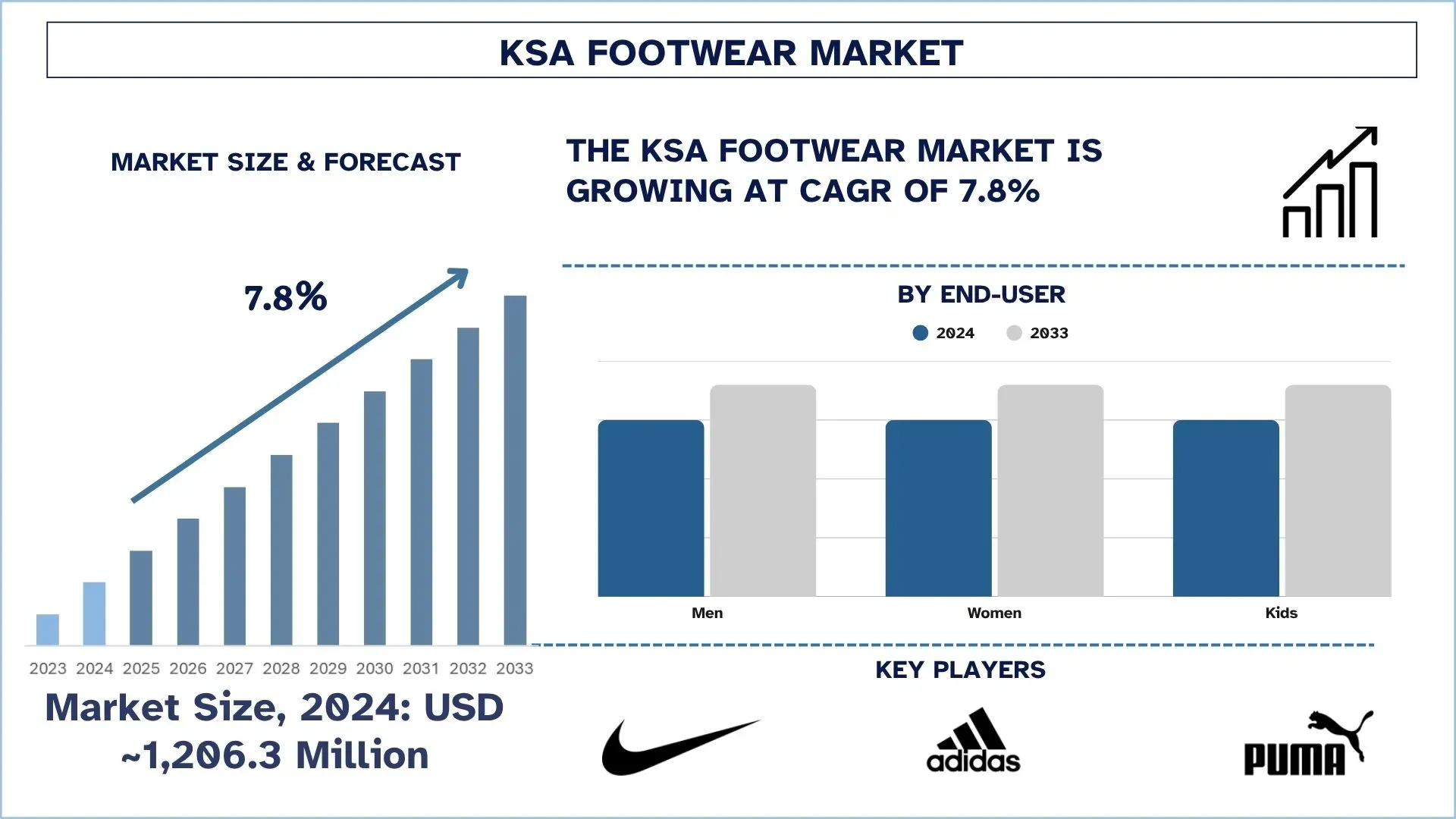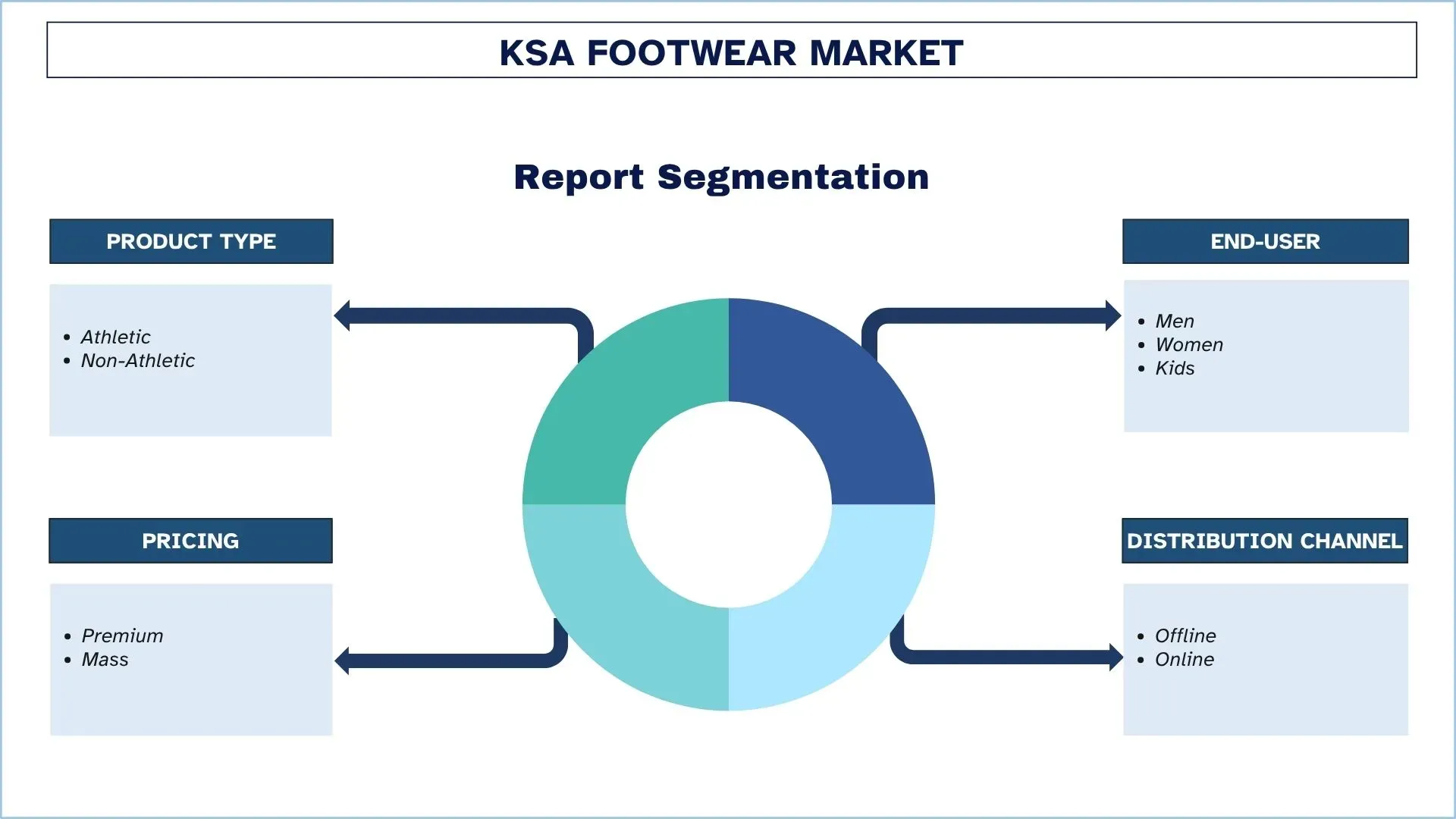- Home
- About Us
- Industry
- Services
- Reading
- Contact Us
KSA Footwear Market: Current Analysis and Forecast (2025-2033)
Emphasis on Product Type (Athletic, and Non-Athletic); End-User (Men, Women, and Kids); Pricing (Premium, and Mass); and Distribution Channel (Offline, and Online)

KSA Footwear Market Size & Forecast
The KSA Footwear market was valued at USD 1,206.3 million in 2024 and is expected to grow to a strong CAGR of around 7.8% during the forecast period (2025-2033F), owing to the rising disposable incomes and rapid digital adoption.
KSA Footwear Market Analysis
Growth in fashion interest and a marked rise in population are helping to drive the rapidly changing Saudi Arabian footwear market. In 2024, the market reached a worth of more than USD 1.2 billion, and it is expected to maintain a CAGR of 7.8% until 2030. People’s income is on the rise to approximately USD 18,260 a year, by 2025, and fresh views on style acquired in big cities from seeing foreign trends are what grows the industry. Through its popularity, social media has helped make brand names like Nike, Adidas, Skechers, and Puma, and luxury brands like Gucci and Christian Dior Couture, more well-known. Being home to a large number of young people, Saudi Arabia needs fashion and efficient footwear for many. Moreover, since women now participate more fully in society, the market for both regular and fashion footwear has expanded.
Fewer Saudis rely on online shopping and prefer to go to stores and malls to buy footwear. However, due to COVID-19, the sales that happen online have become much stronger. Purchasing shoes on the Internet rose from 3% in 2018 to almost XX% in 2024. Because of fintech, items such as BNPL and mobile wallets have become popular, pushing the industry upwards and attracting both Gen Z and professional customers. Thanks to places like The Avenues Riyadh and Diriyah Gate, Saudi Arabia’s two biggest cities have become fashion leaders and draw brands from across the globe. All things considered, the growth in the Saudi footwear industry is fast due to shifts in culture, modern technology, and sound investments, bringing many opportunities to everyone in the field.
KSA Footwear Market Trends
This section discusses the key market trends that are influencing the various segments of the KSA Footwear market, as found by our team of research experts.
Market Growth and Economic Drivers
There has been continuous growth in the Saudi Arabian footwear market. It’s caused by more spending power, a fast rise in city populations, and the youth market’s desire to spend on up-to-date styles and lifestyle items. Vision 2030, introduced by the government, has helped increase economic diversity and supported more mall and multi-branded outlet construction in the cities of Riyadh and Jeddah. Thanks to this improvement, consumers find it simpler to discover many types of footwear. In addition, people becoming more open to new trends in fashion and lifestyle have pushed up spending on footwear, bringing together classic and contemporary styles.
E-Commerce Expansion
Online shopping is having a big impact on the Saudi footwear industry. Because so many Saudi people are connected and use technology, they have quickly taken to shopping online. You can find an exceptional variety of footwear branded from around the world on platforms such as Amazon, Noon, and Namshi. Modern logistics, safe ways to pay online, and features like virtual models are making shopping online easy. The COVID-19 pandemic made many temporary changes in the way people shop, which has helped online sales keep increasing.
Sustainability and Ethical Practices
When buyers in Saudi Arabia look for shoes, they are focusing on environmentally friendly ones more. As a result, a lot of businesses choose eco-friendly approaches to please their customers. Interest in buying eco-friendly, recycled, or natural shoe material is increasing year after year. Several organizations hope to ease the process of checking supply chains to highlight their commitment to the environment. One of Vision 2030’s goals is to care more for the environment, and companies thought about this from the start. Now that many people opt to fix their shoes instead of replacing them, shoe repair shops are opening up. Since many investors hold this view, the public is continuously advised to keep traditions and behave wisely.
Rise of Athleisure and Sports Footwear
As taking care of your health is growing in importance, and because the government promotes sports, athleisure, and sports shoes are now very popular in the country. Sporty shoes that are also stylish are helping firms succeed across the globe. Because of developments in footwear, shoes are made to change with both the climate and customers’ tastes. Saudis now wear athleisure every day, not only for work. Providing comfort, style, and exceptional performance forces a company to collect more customers and contribute to market advancement.

Luxury Footwear Market
The segment grows because of the rise in wealth for many, the desire among youth to follow fashion trends, and the wish to be considered exclusive because of high-end products. Designer shoe and bespoke product lovers are drawn to the well-known luxury brands’ flagship stores in major cities. Since social media influencers and celebrities affect buying choices, more people want limited-edition and special items. Luxury footwear with smart and custom features is attractive to buyers who want the links between style, technology, and a limited-edition product. Therefore, the luxury market is known for its great opportunities and fast movement.
KSA Footwear Industry Segmentation
This section provides an analysis of the key trends in each segment of the KSA Footwear market report, along with forecasts for 2025-2033.
Non-Athletic Category Dominates the KSA Footwear Market.
Based on Product Type, the market is segmented into Athletic, and Non-Athletic. Among these, the Non-Athletic segment is leading the market. Durable, yet trendy athletic footwear is currently the highest-selling item in this market, mainly led by young Saudis. Since the majority of Saudi Arabia’s population is around 30, many locals seek out well-known brands and styles when getting dressed. The growth in the uptrend happens because people are gaining financial independence, living in urban areas, and spending more hours online. As women are allowed to participate more in public due to evolving cultures in Saudi Arabia, their share in footwear is growing rapidly. This has caused Gucci, Christian Dior, and Jimmy Choo to add more products and show collections tailored to what locals enjoy, and local stores are doing the same.
The Men Category Dominates the KSA Footwear Market.
Based on the End-User, the market is segmented into Men, Women, and Kids. Among these, Men is the largest contributor to the KSA Footwear industry. Due to the large number of males working in Saudi Arabia and their emphasis on neat and clean clothing, men’s shoes do well, selling for both work and casual occasions. Since more men are finding work and joining in on social and religious activities, they now purchase sandals, loafers, and formal shoes. Besides, the presence of popular global trends and big brands, as well as rising incomes, has increased the demand in this area.
KSA Footwear Industry Competitive Landscape
The KSA Footwear market is competitive, with several global and international market players. The key players are adopting different growth strategies to enhance their market presence, such as partnerships, agreements, collaborations, new product launches, geographical expansions, and mergers and acquisitions.
Top KSA Footwear Companies
Some of the major players in the market are Nike (Sun and Sand Sports), Adidas (Delta Marketing, Reza Group), Puma (Beside Group), Reebok (Al Boom Marine), Skechers (Apparel Group), Jimmy Choo (Saudi Jawahir Trading Company), Gucci (G Distribution B.V. and Al Rubaiyat Co), Prada Saudi Arabia Ltd, Christian Dior Couture, and Crocs Gulf.
Recent Developments in the KSA Footwear Market
On October, 2024, Apparel Group, a prominent fashion and lifestyle conglomerate, has announced the acquisition of 12 Nine West stores in the Kingdom of Saudi Arabia, marking a strategic expansion of its retail footprint in the region. This acquisition reinforces the Group’s growing presence in the Saudi market and aligns with its broader strategy to enhance brand offerings and consumer reach.
KSA Footwear Market Report Coverage
Details | |
Base year | 2024 |
Forecast period | 2025-2033 |
Growth momentum | Accelerate at a CAGR of 7.8% |
Market size 2024 | USD 1,206.3 Million |
Companies profiled | Nike (Sun and Sand Sports), Adidas (Delta Marketing, Reza Group), Puma (Beside Group), Reebok (Al Boom Marine), Skechers (Apparel Group), Jimmy Choo (Saudi Jawahir Trading Company), Gucci (G Distribution B.V. and Al Rubaiyat Co), Prada Saudi Arabia Ltd, Christian Dior Couture, and Crocs Gulf |
Report Scope | Market Trends, Drivers, and Restraints; Revenue Estimation and Forecast; Segmentation Analysis; Demand and Supply Side Analysis; Competitive Landscape; Company Profiling |
Segments Covered | By Product Type; By End-User; By Pricing; By Distribution Channel |
Reasons to Buy KSA Footwear Market Report:
The study includes market sizing and forecasting analysis confirmed by authenticated key industry experts.
The report briefly reviews overall industry performance at a glance.
The report covers an in-depth analysis of prominent industry peers, primarily focusing on key business financials, type portfolios, expansion strategies, and recent developments.
Detailed examination of drivers, restraints, key trends, and opportunities prevailing in the industry.
The study comprehensively covers the market across different segments.
Customization Options:
The KSA Footwear market can further be customized as per the requirements or any other market segment. Besides this, UnivDatos understands that you may have your own business needs, hence feel free to contact us to get a report that completely suits your requirements.
Table of Content
Research Methodology for the KSA Footwear Market Analysis (2023-2033)
We analyzed the historical market, estimated the current market, and forecasted the future market of the KSA Footwear market to assess its application. We conducted exhaustive secondary research to gather historical market data and estimate the current market size. To validate these insights, we carefully reviewed numerous findings and assumptions. Additionally, we conducted in-depth primary interviews with industry experts across the KSA Footwear value chain. After validating market figures through these interviews, we used both top-down and bottom-up approaches to forecast the overall market size. We then employed market breakdown and data triangulation methods to estimate and analyze the market size of industry segments and sub-segments.
Market Engineering
We employed the data triangulation technique to finalize the overall market estimation and derive precise statistical numbers for each segment and sub-segment of the KSA Footwear market. We split the data into several segments and sub-segments by analyzing various parameters and trends, including Product Type, End-User, Pricing, and Application within the KSA Footwear market.
The Main Objective of the KSA Footwear Market Study
The study identifies current and future trends in the KSA Footwear market, providing strategic insights for investors. It highlights market attractiveness, enabling industry participants to tap into untapped markets and gain a first-mover advantage. Other quantitative goals of the studies include:
Market Size Analysis: Assess the current and forecast market size of the KSA Footwear market and its segments in terms of value (USD).
KSA Footwear Market Segmentation: Segments in the study include areas of Product Type, End-User, Pricing, and Application
Regulatory Framework & Value Chain Analysis: Examine the regulatory framework, value chain, customer behavior, and competitive landscape of the KSA Footwear industry.
Company Profiles & Growth Strategies: Company profiles of the KSA Footwear market and the growth strategies adopted by the market players to sustain in the fast-growing market.
Frequently Asked Questions FAQs
Q1: What is the KSA Footwear market’s current market size and growth potential?
The KSA Footwear market was valued at USD 1,206.3 million in 2024 and is expected to grow at a CAGR of 7.8% from 2025 to 2033, supported by rising disposable incomes and rapid digital adoption.
Q2: Which segment has the largest share of the KSA Footwear market by Product Type?
The Non-Athletic segment holds the largest market share in 2024, driven by a strong demand for formal, casual, and luxury footwear in both urban and semi-urban areas.
Q3: What are the driving factors for the growth of the KSA Footwear market?
Key growth factors include:
• Rapid urbanization and increasing participation in modern retail
• Rising middle-class incomes and changing consumer lifestyles
• Growth of online and omnichannel shopping platforms
• High brand consciousness and demand for premium products
Q4: What are the emerging technologies and trends in the KSA Footwear market?
Emerging trends and technologies include:
• Smart footwear integrating fitness tracking and wearable tech
• Use of sustainable materials (e.g., vegan leather, recycled fabrics)
• Growth of D2C (Direct-to-Consumer) and social commerce
• Advanced supply chain analytics for inventory and delivery optimization
Q5: What are the key challenges in the KSA Footwear market?
The market faces several challenges:
• High dependency on imports, making prices vulnerable to global supply chain disruptions
• Stiff competition from international brands and fast fashion retailers
• Cultural sensitivities around fashion and brand positioning
Q6: Who are the key players in the KSA Footwear market?
Leading companies in the KSA Footwear market include:
• Nike (Sun and Sand Sports)
• Adidas (Delta Marketing, Reza Group)
• Puma (Beside Group)
• Reebok (Al Boom Marine)
• Skechers (Apparel Group)
• Jimmy Choo (Saudi Jawahir Trading Company)
• Gucci (G Distribution B.V. and Al Rubaiyat Co)
• Prada Saudi Arabia Ltd
• Christian Dior Couture
• Crocs Gulf
Q7: What are the investment opportunities in the KSA Footwear market?
Promising areas for investment include:
• Development of smart and performance footwear
• Expansion of online retail platforms and last-mile logistics
• Localization of retail supply chains to reduce import reliance
• Growth in women’s and children’s footwear categories
Q8: How are regulations affecting the KSA Footwear market?
Regulations are significantly influencing the market, including:
• Saudi Arabia’s import compliance rules under Vision 2030, promoting local content development
• Implementation of Saudization policies, requiring local employment in retail
• Tariff adjustments and standardization policies affecting product labeling and sustainability compliance
Related Reports
Customers who bought this item also bought










